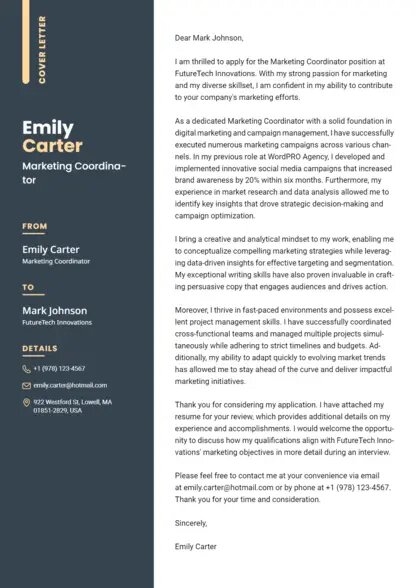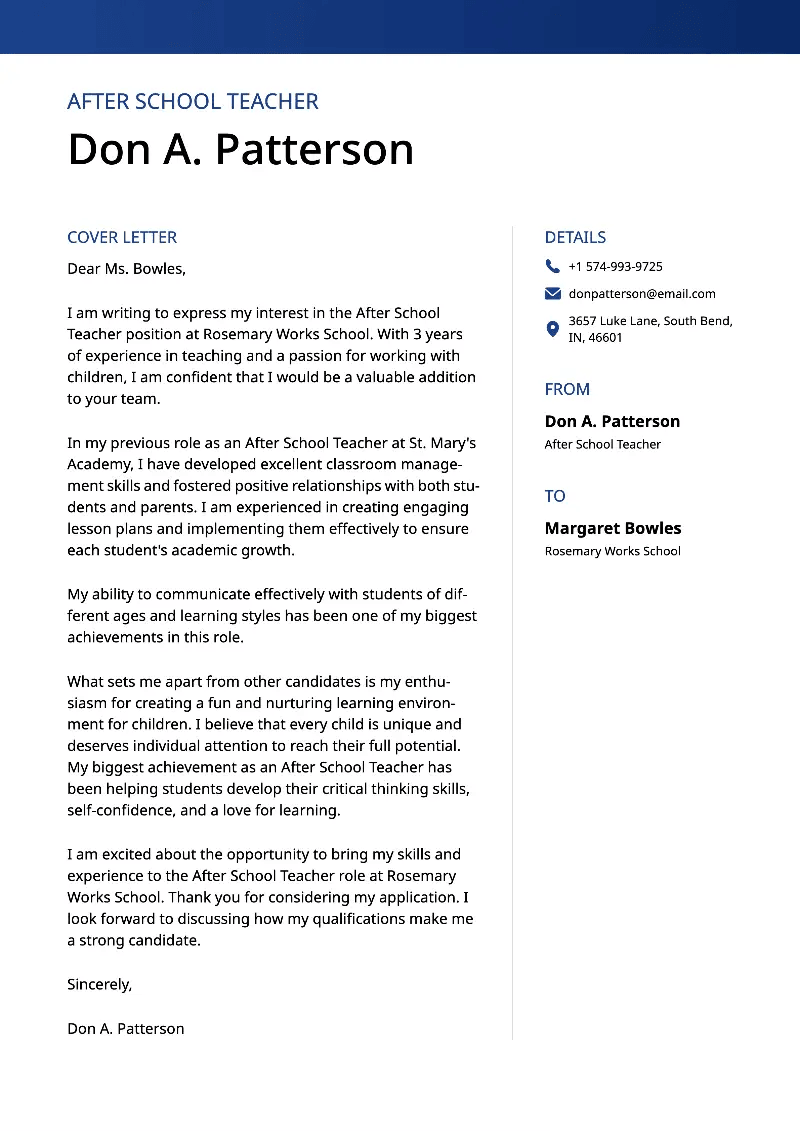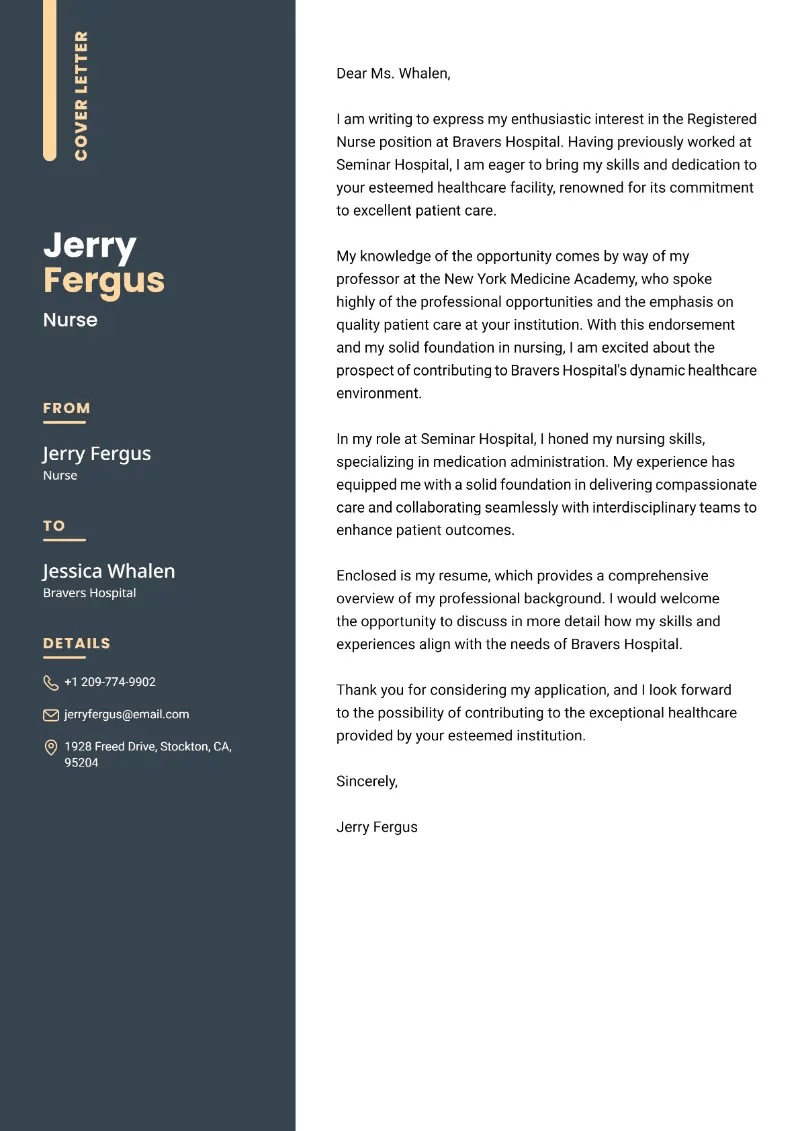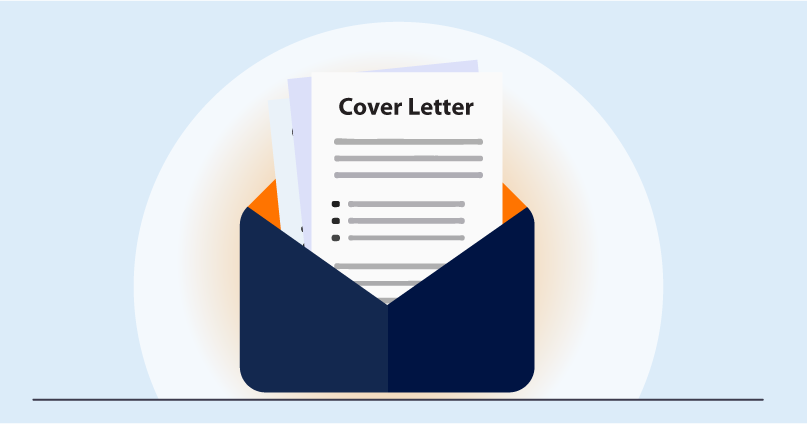
A cover letter is a document that you include with your resume when applying for a job. It introduces you to the hiring manager and emphasizes your skills and experience that make you a good fit for the position.
It’s an opportunity to express yourself beyond what’s on your resume, explain why the job appeals to you, and show how your qualifications and experience can be useful.
Types of Cover Letters
It’s helpful to know how to write a cover letter and the types of cover letters available. Here are the seven main types of letters:
| Type | Description |
| Traditional Cover Letter. | This type of cover letter is just what it sounds like: traditional. It’s ideal for jobs that require a more structured and formal approach. Begin with your contact information, then the date, and finally the interviewer’s information. Advertise yourself and explain why you want the role. Describe your skills and experiences, and be sure to thank the hiring managers for their time. |
| Creative Cover Letter. | When applying for artistic positions, such as those in advertising or design, you should highlight your creativity in your cover letter. Use strong language to show your dedication and highlight your unique expertise. At the same time, ensure that your approach remains professional and respectful. |
| Cold Contact Cover Letter. | Create a cover letter to send to a potential employer even if they have not advertised a position. Demonstrate your understanding of the employer and how your skills meet their requirements. |
| Referral Cover Letter. | In this case, someone has referred you to the role. Mention the referral in your opening line and explain what their connection to you is. Then, provide evidence of why you would be a great fit for the job. |
| Networking Cover Letter. | This kind of cover letter is employed when applying for positions through networking. This letter should include details about how and where you met the contact and what was discussed during the conversation. |
| Transferable Skills Cover Letter. | In this type, focus on hard skills from previous occupations that make you suitable for the job. Show what advantages these skills can offer and explain transitions in your career trajectory or why you’re seeking to enter a new sector. |
| Follow-up Cover Letter. | If you’ve already applied for a job or had an interview but haven’t received a response, a follow-up letter can help remind them of your interest in the position and put you back on their radar! Do not be too pushy. Just make sure you thank them for their time and express your excitement about joining their team if selected. |
How to Write a Cover Letter
A cover letter builder can be an excellent resource for those looking to write compelling application essays. It takes away the guesswork from creating an impressive and unique cover letter.
- Constructing a cover letter with a builder is easy and efficient:
- All you have to do is enter in your information. The builder will generate a cover letter example comprising all of this information in a concise format.
- The cover letter builder also allows you to customize your papers with specific words or phrases that are relevant to the job. This makes it easier to tailor your letter and make it stand out from other applicants.
- Another great feature of many cover letter builders is the ability to save and print your document. Make changes or update your letter when necessary. You can also store multiple versions of your letters so you have them on hand when needed.
Overall, using a builder is an excellent way to write a cover letter that will get you noticed by potential employers. With the right cover letter builder, you can create the perfect document.
What to Include in a Cover Letter
A supporting letter is a crucial piece for any job application. It should provide insight into your background and experience.
These are the essential elements of writing a cover letter:
- Your contact information: Start with a name, address, phone number, and email. This ensures that employers can easily contact you.
- The job title: Make certain to specify the role title which you are applying for.
- Introduction: Commence your letter with a polite greeting and introduce yourself. Define your motivation and how your abilities can benefit the company.
- Experience: Underline key experiences that relate to the job description. Showcase relevant achievements or projects that you’ve completed.
- Motivation: Illustrate why you are the best-suited applicant for this role. Express excitement for the position and demonstrate how it fits into your career plan.
- Closing remarks: Conclude by requesting an interview or meeting. Acknowledge the time they gave you and reiterate your desire for the role.
These are some of the most important components of writing a successful cover letter. Writing an outstanding accompanying letter can be a critical step toward getting hired. Make sure to devote the necessary time to developing one that is tailored to the opportunity and highlights your unique qualifications!
Step 1. What to Write About
Before you even start making cover letter, do your analysis. Find out as much as you can about the company you are applying to and the job itself.
- Make sure you know the company’s mission statement and values, and how they match your own. It is also important to read up on any recent press releases or news stories.
- Once you have gathered enough information, customize your letter to the company, job and hiring manager. Show that you understand their needs and what they are looking for in a candidate.
- It is also essential to read the job specification carefully. Jot down any desired capacities or qualifications that prove your experience and remember to mention them in your letter.
- Finally, use language that shows you have done your analysis. Include words related to the work culture and operate examples from your past that match firm demands. Doing so will demonstrate that you are a knowledgeable, enthusiastic competitor who is well-suited for the role.
Step 2. Look Ahead
To make things easier, base your cover letter structure on the future. You want to show potential employers that you are a good fit for the job and that you have a plan in place to make a difference in their organization.
- Provide evidence that you have what it takes to do the job.
- Implement illustrations from past experience to demonstrate your skills and talents.
- Explain how hard and soft skills can benefit the organization and how they will help you achieve its goals in the future.
- Ensure you list certifications or accomplishments that distinguish you from other applicants.
- By centering on how you can bid your competencies and prior knowledge to help them accomplish their aims, you can create an engaging cover letter that highlights your uniqueness.
Step 3. Contact details
How to start a cover letter? It’s important to include your contact information in the letter first. This should comprise your full name, address, phone number, and email.
- Begin by typing your full name in bold, centered at the top of the cover letter header. This is the most important line, so make sure it stands out.
- Below that, incline your physical address. Include the city, state, or province and zip code.
- Finally, enter your contact details in this format: “(555) 555-5555” or “name@email.com”. Employ a professional-sounding email address that includes some variation of your name.
Step 4. Cover Letter Intro
Continue writing a cover letter by addressing the person responsible for hiring directly. This shows them that you are serious about the position and conducted your investigation.
- Start making a cover letter with a formal salutation, such as “Dear [Name]”, or “To [Name]”, followed by a colon. If you don’t know the name of the HR, you may handle a generic greeting such as, “Dear Hiring Manager”, or “To Whom It May Concern”.
- Don’t leave the reader guessing your identity and purpose for composing. After your greeting, provide context by briefly introducing yourself and outlining the reasons why you are keen to join the role.
- If you have been referred to the company by someone else, remember to point out it as well. This can give your application an edge over other job-seekers and show that you have professional connections in the industry.
Step 5. Explain Your Enthusiasm
What should your cover letter say? It is critical to express your enthusiasm for the company you are applying to. Highlighting your desire to join the company can mean the difference between getting a job interview and having your application ignored.
- When creating a cover letter tell why you’d be a great addition to the team. For example, if you have previous experience in the same industry or have completed a relevant course, use it to your advantage. Make sure to highlight how your qualifications match those of the job vacancy.
- Don’t forget to mention any awards or recognition. Any recognition of your hard work demonstrates to prospective employers that you possess great capability and strong determination to succeed.
By highlighting your ability to fit into their organization and contribute immediately, employers will be impressed with your enthusiasm and commitment. Make sure that after reading the cover letter, employers know why they should hire you!
Step 6. Support Your Credentials
What else should I include in a cover letter? It is essential to back up your claims about your qualifications with specific examples and figures. Illustrating how you have proven yourself in the past is an effective strategy for convincing potential bosses that you are the right person for the job.
Here are some strategies on how to accomplish this effectively:
- Using a cover letter example for inspiration describe the scope of work you have done.
- If possible, quantify your accomplishments.
- Detail the results of any projects you have worked on.
- Talk about any special skills or knowledge you have acquired that will be useful in this job.
By providing concrete evidence of your qualifications in the form of illustrations and figures, you can dramatically advance the impact. It’s easy to make big claims – but it’s much more convincing when you can back them up with facts!
Step 7. Watch the Tone
Tone of cover letter structure matters. The quality of the cover letter template and the choice of words can have a great influence on whether or not you receive an interview.
- Utilize terms that are professional and relevant to the job opening you are attempting to fill. Affect a formal style, rather than a casual one. Don’t be overly familiar with the reader, and don’t be too stiff either.
- Be careful not to sound too optimistic or boastful. Confirm you keep your letter of application concise and stick to the point.
- Show enthusiasm for the position, but don’t appear desperate.
- Try to make sure your sentences are clear and effortless to understand. Attempt to use active verbs instead of passive ones.
- Create a cover letter different and tailored to each job opportunity.
Pay attention to spelling and grammar mistakes as these could put off potential employers. Double-check the cover letter for typos before handing it in!
Step 8. Strong Conclusion
A cover letter needs to have a powerful closing statement. It’s the last thing your reader will see and should leave a lasting impression.
- Commence with an appreciation of the reader for devoting their time and consideration. Show that you appreciate their efforts to consider you as a candidate.
- Make a cover letter call to action, inviting the reader to contact you to discuss your qualifications further or request an interview. Include your number or email address so they can get in touch quickly and easily.
Remember to tailor these suggestions to the specific context of your cover letter and the position you’re applying for. The goal is to instill a sense of urgency and enthusiasm in the reader, encouraging them to take action and move your application forward.
Step 9. Cover Letter Closing Salutation
A formal ending salutation should be used every time.
- Start with “Sincerely”, and add your name after it. This will assure it is professional and respectful. Avoid using phrases that are too casual, such as “Take care” or “Talk soon”. Verify you employ the same name that you applied on the header.
You can also write a cover letter postscript (P.S.). This should be a short sentence that reiterates that you are the perfect match for the position. It can emphasize some of your best qualities and experiences
Step 10. Improve the Cover Letter
After you’ve written the cover letter, take the time to go over it again and make any necessary changes. Make sure all of your points are clear and concise. Check for grammatical, spelling, and punctuation errors. Make sure the letter’s viewpoint is appropriate.
- Look for any areas where you can enhance or make the letter more succinct. Contemplate if there are any points that need further explanation or could be clarified. Eliminate any words or phrases that don’t give value to your message.
- Review the job description again to make sure that you addressed all requirements in your letter. Double-check the company name and contact information if you included them in your letter.
With a few modifications, you can write a superior cover letter that will set you apart from the rest.
Step 11. Get Feedback
When you’ve finished writing a cover letter, seek feedback from a friend or colleague. It is beneficial to seek outside advice so that you can better understand how to write a perfect cover letter.
They can assist you in identifying any grammar and spelling errors. Furthermore, they can ensure that the cover letter is written in a professional style.
- Make sure you ask for an honest response. You want to hear what the reviewer has to say. Don’t take it personally if they suggest changes. If the individual has any experience in the job market, their advice can be especially helpful.
- If you don’t have any friends or colleagues to provide a reply, there are other resources available. Professional resume writers offer cover letter critiques and direction. You can use websites like Indeed and Glassdoor to get guidance from the experts.
- Recite your cover letter aloud before submitting it. This will help you catch any awkward phrasing or errors that you might have missed. After reading the letter out loud, ask yourself if it makes sense and if it’s written in a businesslike tone.
Getting feedback on your letter of application is essential. It helps guarantee that your writing is up to par and offers a fresh perspective on what you’ve written. So don’t hesitate to reach out for help with the cover letter!
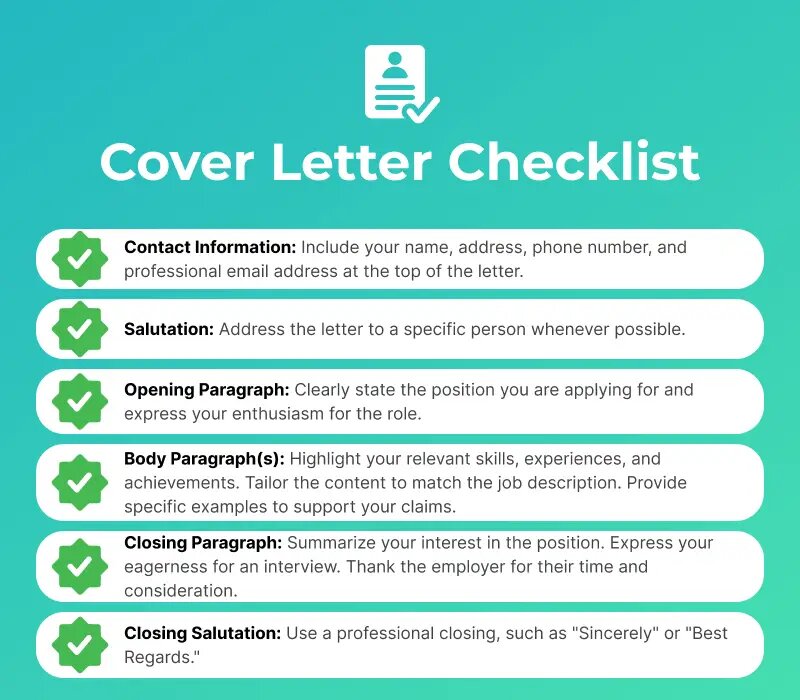
Tip:
Even if employers explicitly state that they do not accept cover letters or if there is no designated space for one on the job application, it is still beneficial to include a cover letter in your application strategy.
Consider including a brief and impactful supporting letter as a separate document alongside your resume. In your email or application submission, express your understanding of their preferred application format and briefly express your enthusiasm for the job.
Mention that you have attached a cover letter outlining your qualifications and genuine interest in the position. This proactive approach ensures that the hiring team has the opportunity to review your complete application package while adhering to their specific application guidelines.
PRO TIP: Nothing will get your cover letter thrown in the recycling bin faster than giving the wrong company name. – Chaz Kyser, founder of Careeranista
What not to do:
- Don’t use a generic pre-written template of a cover letter. It’s important to be tailored specifically to the role you’re applying for.
- Don’t repeat the same information from your resume when writing a cover letter. It should involve additional evidence as to why you are the ideal match for the role.
- Don’t focus solely on your qualifications and skills. Companies don’t only care about what you can do; they want to know why you want the job and how you can add value.
- Don’t utilize a impersonal greeting; try to find out who the hiring manager is and address them directly.
- Don’t make spelling and grammar mistakes. Read the cover letter carefully before sending it and ask someone else to proofread it too.
- Don’t go over one page in length. Keep the letter concise and no longer than a single page.
- Don’t use jargon or overly complicated language. The cover letter should be easy to read and understand, so escape using too technical words that might confuse the reader.
- Don’t include information that isn’t relevant. Make sure that you don’t incline any information that doesn’t add anything to your application. As it could potentially damage your chances of getting hired.
By avoiding these common mistakes when composing the cover letter, you’ll be able to present yourself in the best feasible light and have a better chance of getting an interview!
Questions to guide you through the writing process:
- What do I know about the firm? Research the job and company to recognize vital abilities and characteristics desired in an applicant.
- What value can I bring to the occupation? Showcase any special qualifications or experiences that you believe make you a standout among other applicants.
- How can I show enthusiasm and interest in the role? Demonstrate your passion by focusing on the company’s goals and how your skillset can help them attain those.
- What other information should I include? Consider adding a few admissible accomplishments, an example of your work, or a link to your online portfolio.
- Who will be reading my cover letter? Address the letter to an individual if possible, such as the hiring manager or recruiter.
By inquiring about these queries and utilizing them as a reference, you can write a persuasive cover letter that calls the attention of the other job-seekers.
